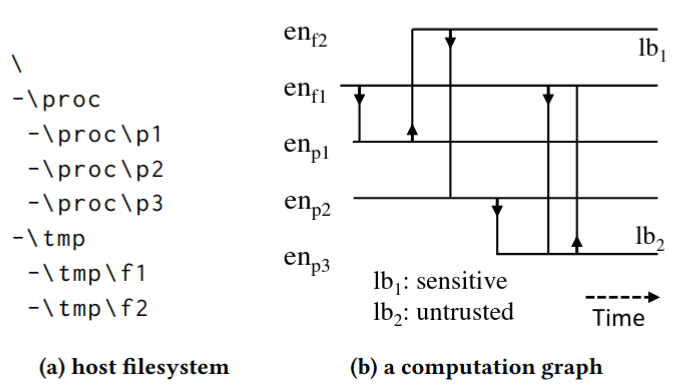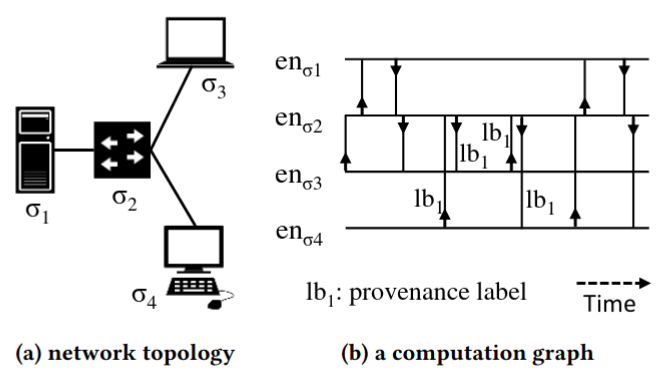Theory Behind Kestrel
We define a hunt as a procedure to find a set of entities in the monitored environment that associates with a cyber threat. We will discuss a more comprehensive definition here as well as the relation between the definitions.
Threat Intelligence Computing
In an ideal world where we can monitor all activities of computations, we can model computations as labeled temporal graphs. Each node in the graph is an entity, and each edge in the graph is an event that happens at a specific time and connects two entities. We call such graph computation graph, and computation graph instances at different monitoring levels, e.g., host-level, network-level, are illustrated below:


A computation graph objectively records all activities of a computation, either benign and malicious parts. If one has access to such computation graphs, one can perform threat hunting as a graph computation problem to find a subgraph associated with each threat. Graph computation does not need to be complicated, and we prove that one only need one type of operation—functional graph pattern matching—to achieve Turing-complete cyber reasoning procedures. Cyber reasoning is a procedure generalized from threat hunting to iteratively finding subgraphs of one’s interest. One may be interested in finding a subgraph that describes a threat, a subgraph that describes the origin of given processes, a subgraph that describes the impacts of a malicious process, etc. Further mitigation can follow such as blocking a traffic flow, killing a process, or shutting down a machine.
We formally define computation graph, model cyber reasoning as a graph computation problem, introduce functional graph pattern matching, and demonstrate the power of it with a prototype cyber reasoning language \({\tau}\)-calculus in the paper Threat Intelligence Computing 1. The establishment of dynamic cyber reasoning via threat intelligence computing largely enhances the detection efficiency of unknown threats, especially against Advanced Persistent Threats (APT) that are dynamically developed and customized for each attack target 2.
Theory And Reality
We cannot assume we get a complete computation graph in reality. We cannot assume all real-world monitored data are connected. While we are pushing for big data security towards complete computation graph, we design Kestrel to use data that exists today even with disconnected entities. We relax the assumptions and derive threat hunting from a subgraph identification problem into a subset identification problem regarding the possible disconnectivity in real-world data. In the meanwhile, we have FIND command in Kestrel to move from one node to another in a real-world incomplete computation graph if the connection exists. And STIX pattern used in GET command provides some capability to express simple graph patterns.
The open source of Kestrel is not an end. It is the beginning to evolve with the entire community including threat hunters, security developers, security vendors, threat intelligence providers, and everyone. We are not retreating from the beautiful and composable functional graph computation methodology for cyber reasoning. We are paving a realistic road towards it.
Acknowledgment
This open source project is built upon research sponsored by the Air Force Research Laboratory (AFRL) and the Defense Advanced Research Agency (DARPA). The fundamental research is part of the DARPA Transparent Computing (TC) and DARPA Cyber-Hunting at Scale (CHASE) program. The views, opinions, and/or findings contained in our papers and talks are those of the authors and should not be interpreted as representing the official views or policies of the Department of Defense or the U.S. Government.
References
- 1
Xiaokui Shu, Frederico Araujo, Douglas L. Schales, Marc Ph. Stoecklin, Jiyong Jang, Heqing Huang, and Josyula R. Rao. 2018. Threat Intelligence Computing. In Proceedings of the 2018 ACM SIGSAC Conference on Computer and Communications Security (CCS ‘18). Association for Computing Machinery, New York, NY, USA, 1883–1898. DOI: https://doi.org/10.1145/3243734.3243829
- 2
Xiaokui Shu. 2020. Unleashing Cyber Reasoning: DARPA Transparent Computing Threat Hunting Retrospective. Sponored talk at Annual Computer Security Applications Conference (ACSAC) ‘20. https://www.youtube.com/watch?v=9IlUoGpXvYo